Clinical Update on COVID-19: Etiology, Pathophysiology, and Treatment
VerifiedAdded on 2023/06/13
|11
|2861
|134
Report
AI Summary
This clinical report provides a comprehensive update on the SARS-CoV-2 (COVID-19) virus, beginning with an introduction that establishes the relevance of the topic through epidemiological data, including the current global and Australian situation. It defines the nature of the disease, its objectives, scope, and structure. The report delves into the etiology and pathophysiology of COVID-19, detailing the causes, types of viruses and variants, risk factors, and the disease's progression, including complications and emerging variants, along with their implications for public health. Clinical manifestations are explained, covering common, less common, and severe signs and symptoms, using the most recent variant as an example. The diagnostic process is thoroughly discussed, explaining how diagnostic tests like PCR and RAT work. Furthermore, the report provides rationales for various treatment options, including pharmacological management (types, action, dosage, side effects, and symptomatic relief) and non-pharmacological treatment options, including symptomatic relief. Finally, it addresses health promotion strategies to prevent the spread of COVID-19, including vaccination, detailing how vaccines work, their effect on immunity, available vaccines in Australia, and how their safety is ensured, alongside the responsible parties for these strategies and their monitoring.
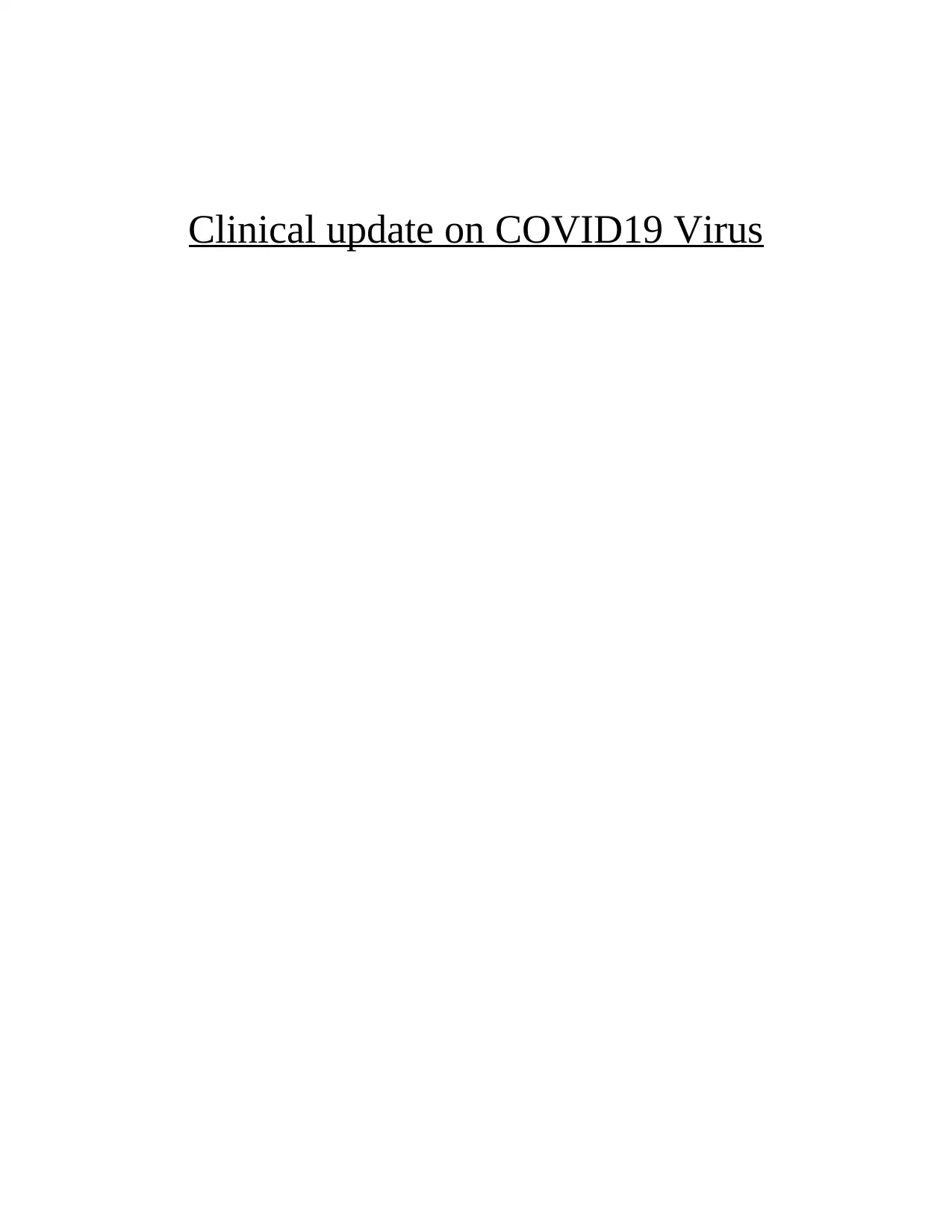
Clinical update on COVID19 Virus
Paraphrase This Document
Need a fresh take? Get an instant paraphrase of this document with our AI Paraphraser
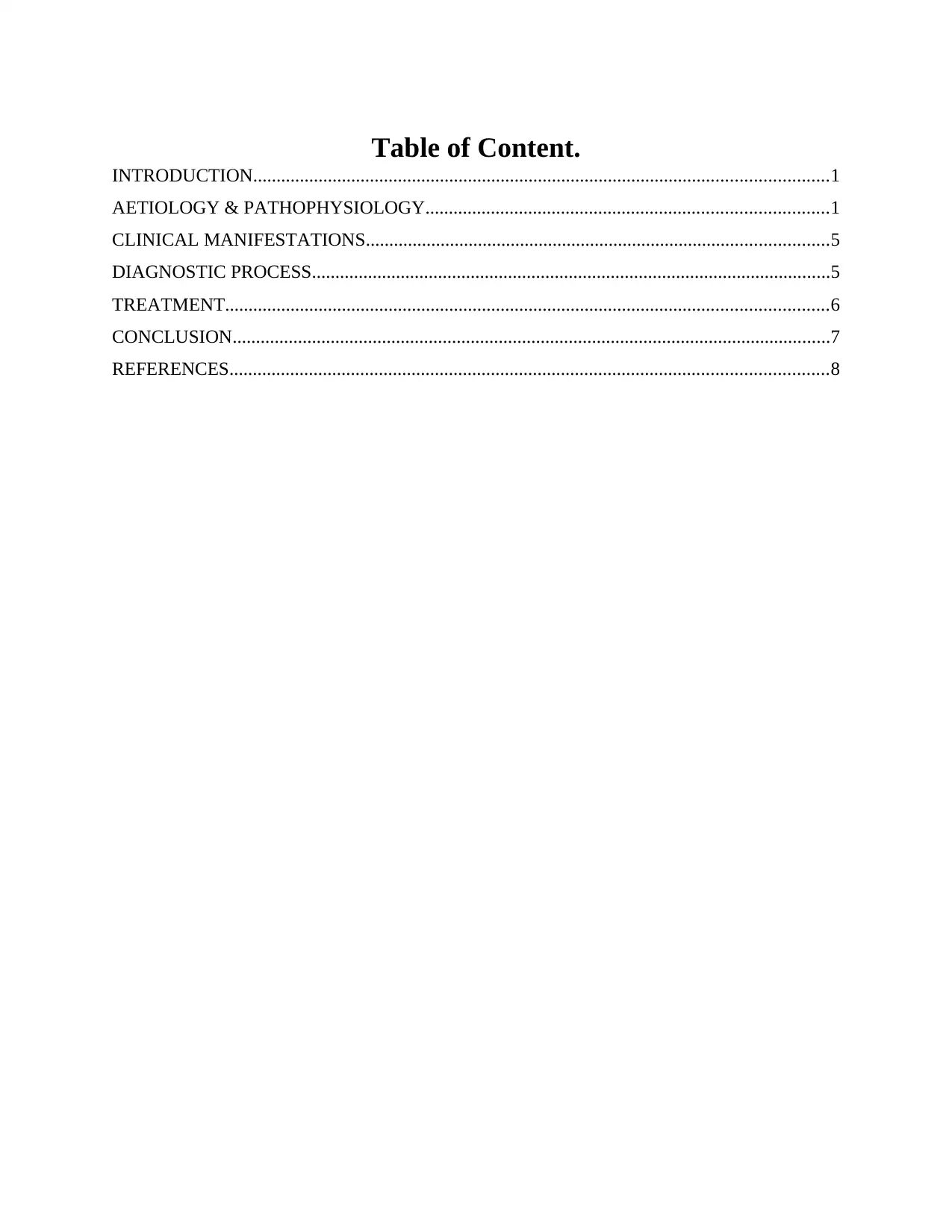
Table of Content.
INTRODUCTION...........................................................................................................................1
AETIOLOGY & PATHOPHYSIOLOGY......................................................................................1
CLINICAL MANIFESTATIONS...................................................................................................5
DIAGNOSTIC PROCESS...............................................................................................................5
TREATMENT.................................................................................................................................6
CONCLUSION................................................................................................................................7
REFERENCES................................................................................................................................8
INTRODUCTION...........................................................................................................................1
AETIOLOGY & PATHOPHYSIOLOGY......................................................................................1
CLINICAL MANIFESTATIONS...................................................................................................5
DIAGNOSTIC PROCESS...............................................................................................................5
TREATMENT.................................................................................................................................6
CONCLUSION................................................................................................................................7
REFERENCES................................................................................................................................8
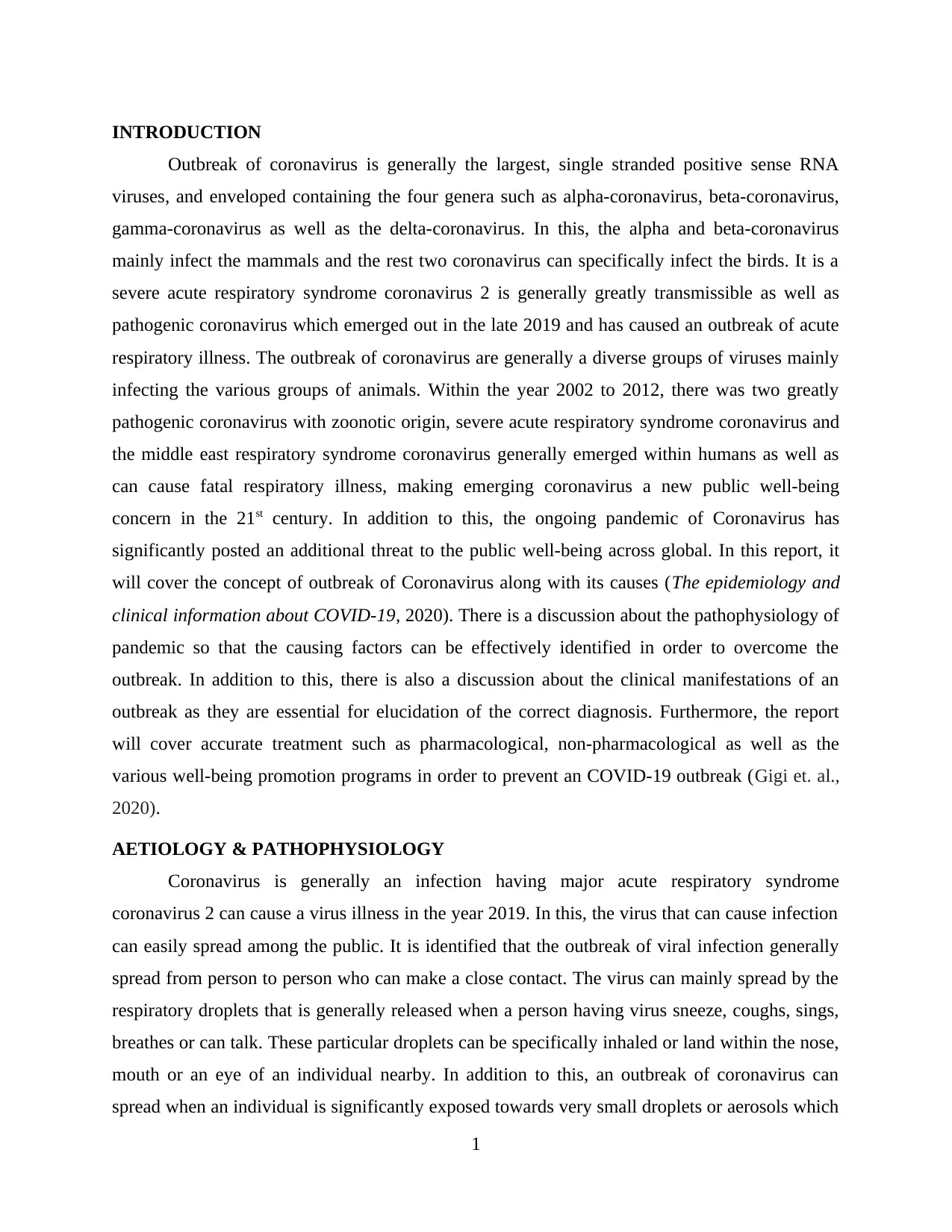
INTRODUCTION
Outbreak of coronavirus is generally the largest, single stranded positive sense RNA
viruses, and enveloped containing the four genera such as alpha-coronavirus, beta-coronavirus,
gamma-coronavirus as well as the delta-coronavirus. In this, the alpha and beta-coronavirus
mainly infect the mammals and the rest two coronavirus can specifically infect the birds. It is a
severe acute respiratory syndrome coronavirus 2 is generally greatly transmissible as well as
pathogenic coronavirus which emerged out in the late 2019 and has caused an outbreak of acute
respiratory illness. The outbreak of coronavirus are generally a diverse groups of viruses mainly
infecting the various groups of animals. Within the year 2002 to 2012, there was two greatly
pathogenic coronavirus with zoonotic origin, severe acute respiratory syndrome coronavirus and
the middle east respiratory syndrome coronavirus generally emerged within humans as well as
can cause fatal respiratory illness, making emerging coronavirus a new public well-being
concern in the 21st century. In addition to this, the ongoing pandemic of Coronavirus has
significantly posted an additional threat to the public well-being across global. In this report, it
will cover the concept of outbreak of Coronavirus along with its causes (The epidemiology and
clinical information about COVID-19, 2020). There is a discussion about the pathophysiology of
pandemic so that the causing factors can be effectively identified in order to overcome the
outbreak. In addition to this, there is also a discussion about the clinical manifestations of an
outbreak as they are essential for elucidation of the correct diagnosis. Furthermore, the report
will cover accurate treatment such as pharmacological, non-pharmacological as well as the
various well-being promotion programs in order to prevent an COVID-19 outbreak (Gigi et. al.,
2020).
AETIOLOGY & PATHOPHYSIOLOGY
Coronavirus is generally an infection having major acute respiratory syndrome
coronavirus 2 can cause a virus illness in the year 2019. In this, the virus that can cause infection
can easily spread among the public. It is identified that the outbreak of viral infection generally
spread from person to person who can make a close contact. The virus can mainly spread by the
respiratory droplets that is generally released when a person having virus sneeze, coughs, sings,
breathes or can talk. These particular droplets can be specifically inhaled or land within the nose,
mouth or an eye of an individual nearby. In addition to this, an outbreak of coronavirus can
spread when an individual is significantly exposed towards very small droplets or aerosols which
1
Outbreak of coronavirus is generally the largest, single stranded positive sense RNA
viruses, and enveloped containing the four genera such as alpha-coronavirus, beta-coronavirus,
gamma-coronavirus as well as the delta-coronavirus. In this, the alpha and beta-coronavirus
mainly infect the mammals and the rest two coronavirus can specifically infect the birds. It is a
severe acute respiratory syndrome coronavirus 2 is generally greatly transmissible as well as
pathogenic coronavirus which emerged out in the late 2019 and has caused an outbreak of acute
respiratory illness. The outbreak of coronavirus are generally a diverse groups of viruses mainly
infecting the various groups of animals. Within the year 2002 to 2012, there was two greatly
pathogenic coronavirus with zoonotic origin, severe acute respiratory syndrome coronavirus and
the middle east respiratory syndrome coronavirus generally emerged within humans as well as
can cause fatal respiratory illness, making emerging coronavirus a new public well-being
concern in the 21st century. In addition to this, the ongoing pandemic of Coronavirus has
significantly posted an additional threat to the public well-being across global. In this report, it
will cover the concept of outbreak of Coronavirus along with its causes (The epidemiology and
clinical information about COVID-19, 2020). There is a discussion about the pathophysiology of
pandemic so that the causing factors can be effectively identified in order to overcome the
outbreak. In addition to this, there is also a discussion about the clinical manifestations of an
outbreak as they are essential for elucidation of the correct diagnosis. Furthermore, the report
will cover accurate treatment such as pharmacological, non-pharmacological as well as the
various well-being promotion programs in order to prevent an COVID-19 outbreak (Gigi et. al.,
2020).
AETIOLOGY & PATHOPHYSIOLOGY
Coronavirus is generally an infection having major acute respiratory syndrome
coronavirus 2 can cause a virus illness in the year 2019. In this, the virus that can cause infection
can easily spread among the public. It is identified that the outbreak of viral infection generally
spread from person to person who can make a close contact. The virus can mainly spread by the
respiratory droplets that is generally released when a person having virus sneeze, coughs, sings,
breathes or can talk. These particular droplets can be specifically inhaled or land within the nose,
mouth or an eye of an individual nearby. In addition to this, an outbreak of coronavirus can
spread when an individual is significantly exposed towards very small droplets or aerosols which
1
⊘ This is a preview!⊘
Do you want full access?
Subscribe today to unlock all pages.

Trusted by 1+ million students worldwide
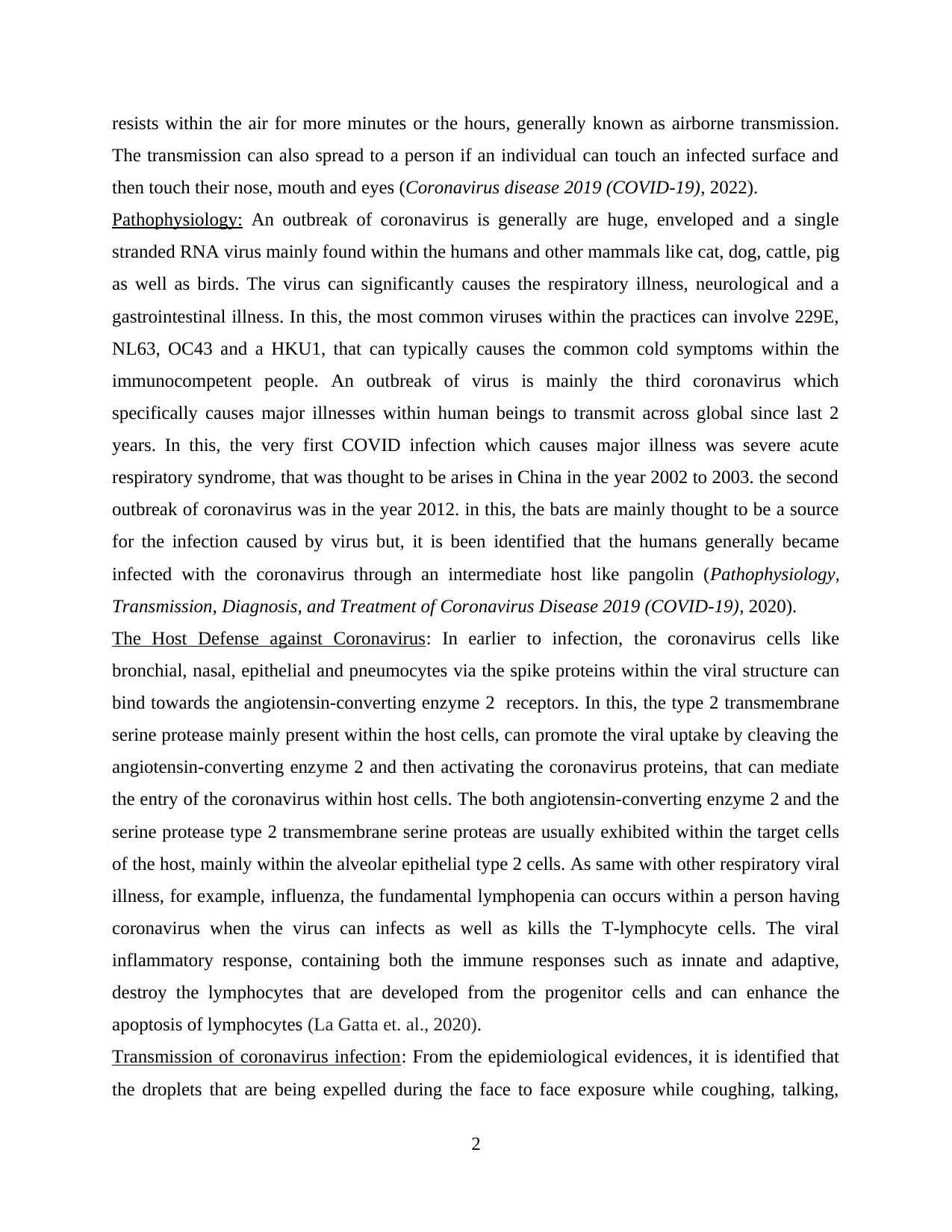
resists within the air for more minutes or the hours, generally known as airborne transmission.
The transmission can also spread to a person if an individual can touch an infected surface and
then touch their nose, mouth and eyes (Coronavirus disease 2019 (COVID-19), 2022).
Pathophysiology: An outbreak of coronavirus is generally are huge, enveloped and a single
stranded RNA virus mainly found within the humans and other mammals like cat, dog, cattle, pig
as well as birds. The virus can significantly causes the respiratory illness, neurological and a
gastrointestinal illness. In this, the most common viruses within the practices can involve 229E,
NL63, OC43 and a HKU1, that can typically causes the common cold symptoms within the
immunocompetent people. An outbreak of virus is mainly the third coronavirus which
specifically causes major illnesses within human beings to transmit across global since last 2
years. In this, the very first COVID infection which causes major illness was severe acute
respiratory syndrome, that was thought to be arises in China in the year 2002 to 2003. the second
outbreak of coronavirus was in the year 2012. in this, the bats are mainly thought to be a source
for the infection caused by virus but, it is been identified that the humans generally became
infected with the coronavirus through an intermediate host like pangolin (Pathophysiology,
Transmission, Diagnosis, and Treatment of Coronavirus Disease 2019 (COVID-19), 2020).
The Host Defense against Coronavirus: In earlier to infection, the coronavirus cells like
bronchial, nasal, epithelial and pneumocytes via the spike proteins within the viral structure can
bind towards the angiotensin-converting enzyme 2 receptors. In this, the type 2 transmembrane
serine protease mainly present within the host cells, can promote the viral uptake by cleaving the
angiotensin-converting enzyme 2 and then activating the coronavirus proteins, that can mediate
the entry of the coronavirus within host cells. The both angiotensin-converting enzyme 2 and the
serine protease type 2 transmembrane serine proteas are usually exhibited within the target cells
of the host, mainly within the alveolar epithelial type 2 cells. As same with other respiratory viral
illness, for example, influenza, the fundamental lymphopenia can occurs within a person having
coronavirus when the virus can infects as well as kills the T-lymphocyte cells. The viral
inflammatory response, containing both the immune responses such as innate and adaptive,
destroy the lymphocytes that are developed from the progenitor cells and can enhance the
apoptosis of lymphocytes (La Gatta et. al., 2020).
Transmission of coronavirus infection: From the epidemiological evidences, it is identified that
the droplets that are being expelled during the face to face exposure while coughing, talking,
2
The transmission can also spread to a person if an individual can touch an infected surface and
then touch their nose, mouth and eyes (Coronavirus disease 2019 (COVID-19), 2022).
Pathophysiology: An outbreak of coronavirus is generally are huge, enveloped and a single
stranded RNA virus mainly found within the humans and other mammals like cat, dog, cattle, pig
as well as birds. The virus can significantly causes the respiratory illness, neurological and a
gastrointestinal illness. In this, the most common viruses within the practices can involve 229E,
NL63, OC43 and a HKU1, that can typically causes the common cold symptoms within the
immunocompetent people. An outbreak of virus is mainly the third coronavirus which
specifically causes major illnesses within human beings to transmit across global since last 2
years. In this, the very first COVID infection which causes major illness was severe acute
respiratory syndrome, that was thought to be arises in China in the year 2002 to 2003. the second
outbreak of coronavirus was in the year 2012. in this, the bats are mainly thought to be a source
for the infection caused by virus but, it is been identified that the humans generally became
infected with the coronavirus through an intermediate host like pangolin (Pathophysiology,
Transmission, Diagnosis, and Treatment of Coronavirus Disease 2019 (COVID-19), 2020).
The Host Defense against Coronavirus: In earlier to infection, the coronavirus cells like
bronchial, nasal, epithelial and pneumocytes via the spike proteins within the viral structure can
bind towards the angiotensin-converting enzyme 2 receptors. In this, the type 2 transmembrane
serine protease mainly present within the host cells, can promote the viral uptake by cleaving the
angiotensin-converting enzyme 2 and then activating the coronavirus proteins, that can mediate
the entry of the coronavirus within host cells. The both angiotensin-converting enzyme 2 and the
serine protease type 2 transmembrane serine proteas are usually exhibited within the target cells
of the host, mainly within the alveolar epithelial type 2 cells. As same with other respiratory viral
illness, for example, influenza, the fundamental lymphopenia can occurs within a person having
coronavirus when the virus can infects as well as kills the T-lymphocyte cells. The viral
inflammatory response, containing both the immune responses such as innate and adaptive,
destroy the lymphocytes that are developed from the progenitor cells and can enhance the
apoptosis of lymphocytes (La Gatta et. al., 2020).
Transmission of coronavirus infection: From the epidemiological evidences, it is identified that
the droplets that are being expelled during the face to face exposure while coughing, talking,
2
Paraphrase This Document
Need a fresh take? Get an instant paraphrase of this document with our AI Paraphraser
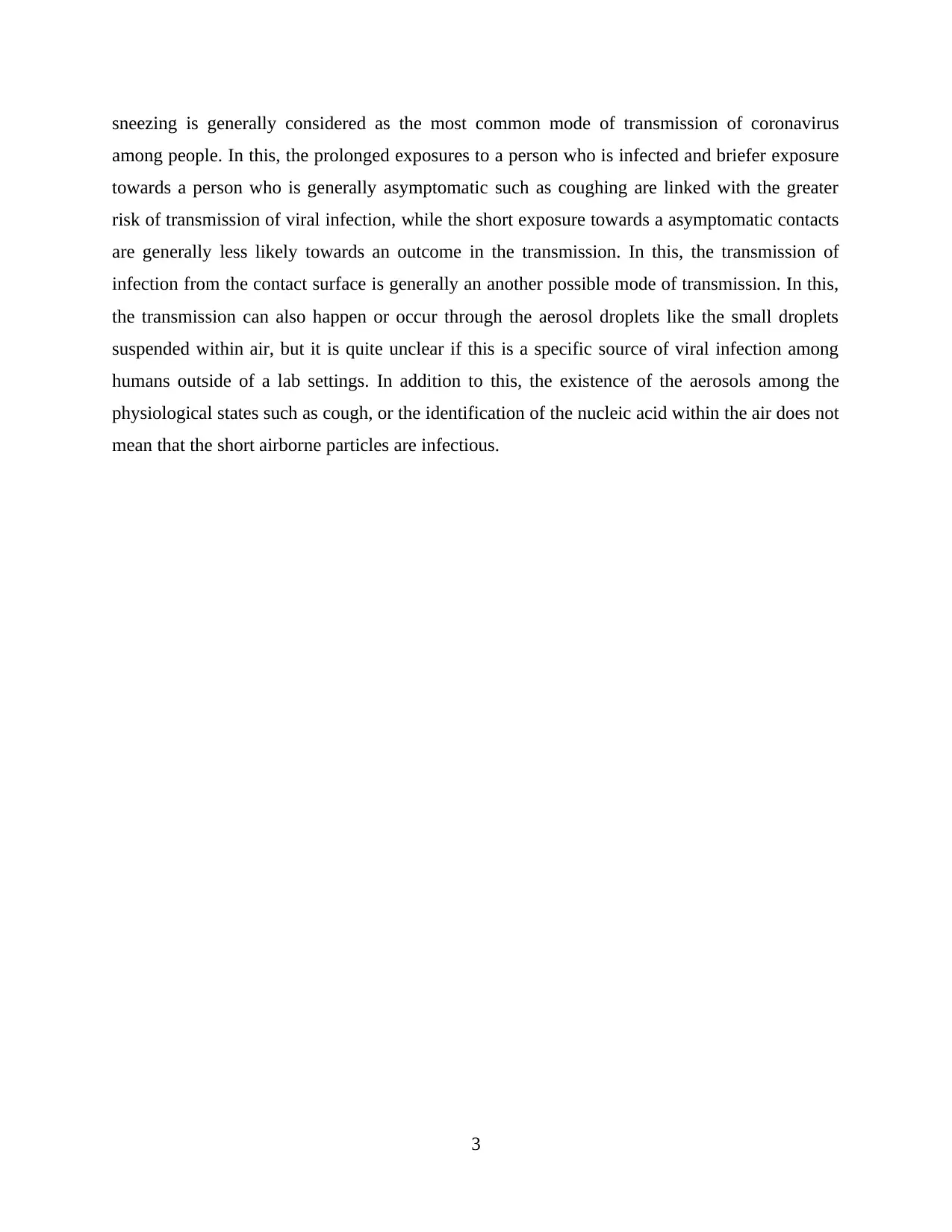
sneezing is generally considered as the most common mode of transmission of coronavirus
among people. In this, the prolonged exposures to a person who is infected and briefer exposure
towards a person who is generally asymptomatic such as coughing are linked with the greater
risk of transmission of viral infection, while the short exposure towards a asymptomatic contacts
are generally less likely towards an outcome in the transmission. In this, the transmission of
infection from the contact surface is generally an another possible mode of transmission. In this,
the transmission can also happen or occur through the aerosol droplets like the small droplets
suspended within air, but it is quite unclear if this is a specific source of viral infection among
humans outside of a lab settings. In addition to this, the existence of the aerosols among the
physiological states such as cough, or the identification of the nucleic acid within the air does not
mean that the short airborne particles are infectious.
3
among people. In this, the prolonged exposures to a person who is infected and briefer exposure
towards a person who is generally asymptomatic such as coughing are linked with the greater
risk of transmission of viral infection, while the short exposure towards a asymptomatic contacts
are generally less likely towards an outcome in the transmission. In this, the transmission of
infection from the contact surface is generally an another possible mode of transmission. In this,
the transmission can also happen or occur through the aerosol droplets like the small droplets
suspended within air, but it is quite unclear if this is a specific source of viral infection among
humans outside of a lab settings. In addition to this, the existence of the aerosols among the
physiological states such as cough, or the identification of the nucleic acid within the air does not
mean that the short airborne particles are infectious.
3
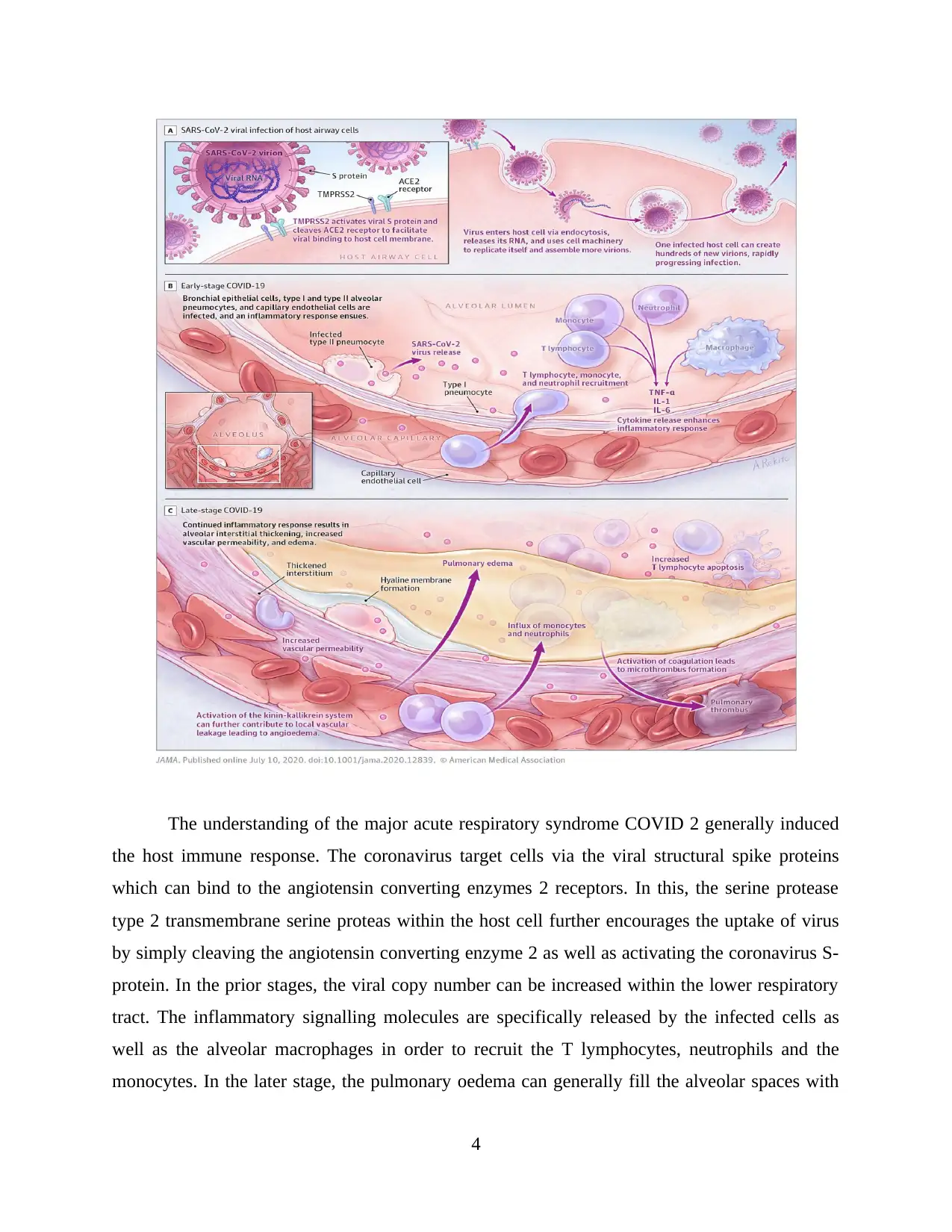
The understanding of the major acute respiratory syndrome COVID 2 generally induced
the host immune response. The coronavirus target cells via the viral structural spike proteins
which can bind to the angiotensin converting enzymes 2 receptors. In this, the serine protease
type 2 transmembrane serine proteas within the host cell further encourages the uptake of virus
by simply cleaving the angiotensin converting enzyme 2 as well as activating the coronavirus S-
protein. In the prior stages, the viral copy number can be increased within the lower respiratory
tract. The inflammatory signalling molecules are specifically released by the infected cells as
well as the alveolar macrophages in order to recruit the T lymphocytes, neutrophils and the
monocytes. In the later stage, the pulmonary oedema can generally fill the alveolar spaces with
4
the host immune response. The coronavirus target cells via the viral structural spike proteins
which can bind to the angiotensin converting enzymes 2 receptors. In this, the serine protease
type 2 transmembrane serine proteas within the host cell further encourages the uptake of virus
by simply cleaving the angiotensin converting enzyme 2 as well as activating the coronavirus S-
protein. In the prior stages, the viral copy number can be increased within the lower respiratory
tract. The inflammatory signalling molecules are specifically released by the infected cells as
well as the alveolar macrophages in order to recruit the T lymphocytes, neutrophils and the
monocytes. In the later stage, the pulmonary oedema can generally fill the alveolar spaces with
4
⊘ This is a preview!⊘
Do you want full access?
Subscribe today to unlock all pages.

Trusted by 1+ million students worldwide
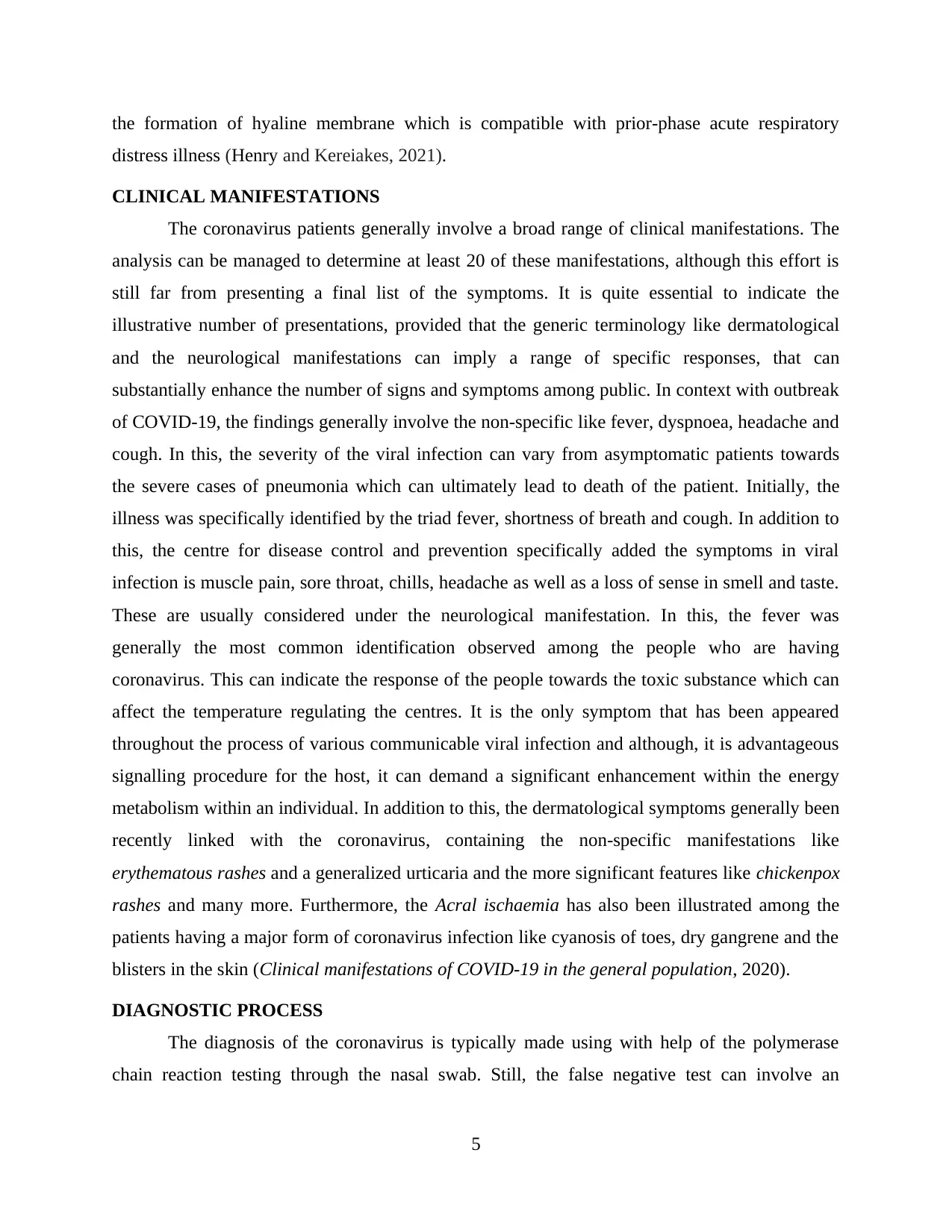
the formation of hyaline membrane which is compatible with prior-phase acute respiratory
distress illness (Henry and Kereiakes, 2021).
CLINICAL MANIFESTATIONS
The coronavirus patients generally involve a broad range of clinical manifestations. The
analysis can be managed to determine at least 20 of these manifestations, although this effort is
still far from presenting a final list of the symptoms. It is quite essential to indicate the
illustrative number of presentations, provided that the generic terminology like dermatological
and the neurological manifestations can imply a range of specific responses, that can
substantially enhance the number of signs and symptoms among public. In context with outbreak
of COVID-19, the findings generally involve the non-specific like fever, dyspnoea, headache and
cough. In this, the severity of the viral infection can vary from asymptomatic patients towards
the severe cases of pneumonia which can ultimately lead to death of the patient. Initially, the
illness was specifically identified by the triad fever, shortness of breath and cough. In addition to
this, the centre for disease control and prevention specifically added the symptoms in viral
infection is muscle pain, sore throat, chills, headache as well as a loss of sense in smell and taste.
These are usually considered under the neurological manifestation. In this, the fever was
generally the most common identification observed among the people who are having
coronavirus. This can indicate the response of the people towards the toxic substance which can
affect the temperature regulating the centres. It is the only symptom that has been appeared
throughout the process of various communicable viral infection and although, it is advantageous
signalling procedure for the host, it can demand a significant enhancement within the energy
metabolism within an individual. In addition to this, the dermatological symptoms generally been
recently linked with the coronavirus, containing the non-specific manifestations like
erythematous rashes and a generalized urticaria and the more significant features like chickenpox
rashes and many more. Furthermore, the Acral ischaemia has also been illustrated among the
patients having a major form of coronavirus infection like cyanosis of toes, dry gangrene and the
blisters in the skin (Clinical manifestations of COVID-19 in the general population, 2020).
DIAGNOSTIC PROCESS
The diagnosis of the coronavirus is typically made using with help of the polymerase
chain reaction testing through the nasal swab. Still, the false negative test can involve an
5
distress illness (Henry and Kereiakes, 2021).
CLINICAL MANIFESTATIONS
The coronavirus patients generally involve a broad range of clinical manifestations. The
analysis can be managed to determine at least 20 of these manifestations, although this effort is
still far from presenting a final list of the symptoms. It is quite essential to indicate the
illustrative number of presentations, provided that the generic terminology like dermatological
and the neurological manifestations can imply a range of specific responses, that can
substantially enhance the number of signs and symptoms among public. In context with outbreak
of COVID-19, the findings generally involve the non-specific like fever, dyspnoea, headache and
cough. In this, the severity of the viral infection can vary from asymptomatic patients towards
the severe cases of pneumonia which can ultimately lead to death of the patient. Initially, the
illness was specifically identified by the triad fever, shortness of breath and cough. In addition to
this, the centre for disease control and prevention specifically added the symptoms in viral
infection is muscle pain, sore throat, chills, headache as well as a loss of sense in smell and taste.
These are usually considered under the neurological manifestation. In this, the fever was
generally the most common identification observed among the people who are having
coronavirus. This can indicate the response of the people towards the toxic substance which can
affect the temperature regulating the centres. It is the only symptom that has been appeared
throughout the process of various communicable viral infection and although, it is advantageous
signalling procedure for the host, it can demand a significant enhancement within the energy
metabolism within an individual. In addition to this, the dermatological symptoms generally been
recently linked with the coronavirus, containing the non-specific manifestations like
erythematous rashes and a generalized urticaria and the more significant features like chickenpox
rashes and many more. Furthermore, the Acral ischaemia has also been illustrated among the
patients having a major form of coronavirus infection like cyanosis of toes, dry gangrene and the
blisters in the skin (Clinical manifestations of COVID-19 in the general population, 2020).
DIAGNOSTIC PROCESS
The diagnosis of the coronavirus is typically made using with help of the polymerase
chain reaction testing through the nasal swab. Still, the false negative test can involve an
5
Paraphrase This Document
Need a fresh take? Get an instant paraphrase of this document with our AI Paraphraser

outcome of coronavirus rates testing the nasal swabs, laboratory as well as imaging findings can
also be used in order to make a presumptive diagnosis.
Diagnostic testing using Polymerase Chain Reaction and Serology: In this, the reverse
transcription PCR based coronavirus RNA identification from the respiratory samples such as
nasopharynx is generally a standard diagnosis. Still, the sensitivity of the testing can vary with
the timings of the testing linked with exposure. In this, there are various serological tests that can
also help in the process of diagnosis as well as the measurement of the responses to the
vaccination. Still, the presence of the antibodies can not confer the immunity, it is because not
every antibodies that are produced in response with the infection are neutralizing. Whether the
presence of antibody alterations susceptibility towards the subsequent contamination or how long
the protection of the antibodies can last are quite unknown. In addition to this, the antibody such
as IgM are specifically identifiable within the five days of the contamination having greater IgM
levels during the 2 to 3 weeks of the infection, while the IgG antibody response is generally the
first detected response within the 14 days after the onset symptom of the viral infection.
TREATMENT
To treat the patients with coronavirus, there are the treatment available such as
pharmacological and non-pharmacological treatments. Along with this, there are also the well-
being promotions in order to prevent the transmission of coronavirus among person to person.
Pharmacological Treatment: While treating the coronavirus patients, the care nurses must use the
best supportive management to treat their patients having failure of acute hypoxic respiratory.
The patients involving the viral infection can require the supplemental oxygen therapy. In
addition to this, there are the medications available such as Remdesivir, tocilizumab, ivermectin,
steroids and favipiravir (Pharmacological treatments of COVID-19, 2020).
Non-pharmacological Treatment: the non-pharmacological treatments that are involved in reduce
the prevalence of coronavirus outbreak can contain social distancing, the personal protective
equipments, testing and contact tracing, and the ventilators or healthcare beds (Pharmacological
and non-pharmacological efforts at prevention, mitigation, and treatment for COVID-19, 2020).
Health Promotion: In this, the community as well as the individual encouragement and its
advocacy are quite effective in response to outbreak. Providing support to the people to act or
gain the control over the situation needs an additional effective communication about the various
developing risks of contamination, about the pathways to protect own and other people's as well
6
also be used in order to make a presumptive diagnosis.
Diagnostic testing using Polymerase Chain Reaction and Serology: In this, the reverse
transcription PCR based coronavirus RNA identification from the respiratory samples such as
nasopharynx is generally a standard diagnosis. Still, the sensitivity of the testing can vary with
the timings of the testing linked with exposure. In this, there are various serological tests that can
also help in the process of diagnosis as well as the measurement of the responses to the
vaccination. Still, the presence of the antibodies can not confer the immunity, it is because not
every antibodies that are produced in response with the infection are neutralizing. Whether the
presence of antibody alterations susceptibility towards the subsequent contamination or how long
the protection of the antibodies can last are quite unknown. In addition to this, the antibody such
as IgM are specifically identifiable within the five days of the contamination having greater IgM
levels during the 2 to 3 weeks of the infection, while the IgG antibody response is generally the
first detected response within the 14 days after the onset symptom of the viral infection.
TREATMENT
To treat the patients with coronavirus, there are the treatment available such as
pharmacological and non-pharmacological treatments. Along with this, there are also the well-
being promotions in order to prevent the transmission of coronavirus among person to person.
Pharmacological Treatment: While treating the coronavirus patients, the care nurses must use the
best supportive management to treat their patients having failure of acute hypoxic respiratory.
The patients involving the viral infection can require the supplemental oxygen therapy. In
addition to this, there are the medications available such as Remdesivir, tocilizumab, ivermectin,
steroids and favipiravir (Pharmacological treatments of COVID-19, 2020).
Non-pharmacological Treatment: the non-pharmacological treatments that are involved in reduce
the prevalence of coronavirus outbreak can contain social distancing, the personal protective
equipments, testing and contact tracing, and the ventilators or healthcare beds (Pharmacological
and non-pharmacological efforts at prevention, mitigation, and treatment for COVID-19, 2020).
Health Promotion: In this, the community as well as the individual encouragement and its
advocacy are quite effective in response to outbreak. Providing support to the people to act or
gain the control over the situation needs an additional effective communication about the various
developing risks of contamination, about the pathways to protect own and other people's as well
6
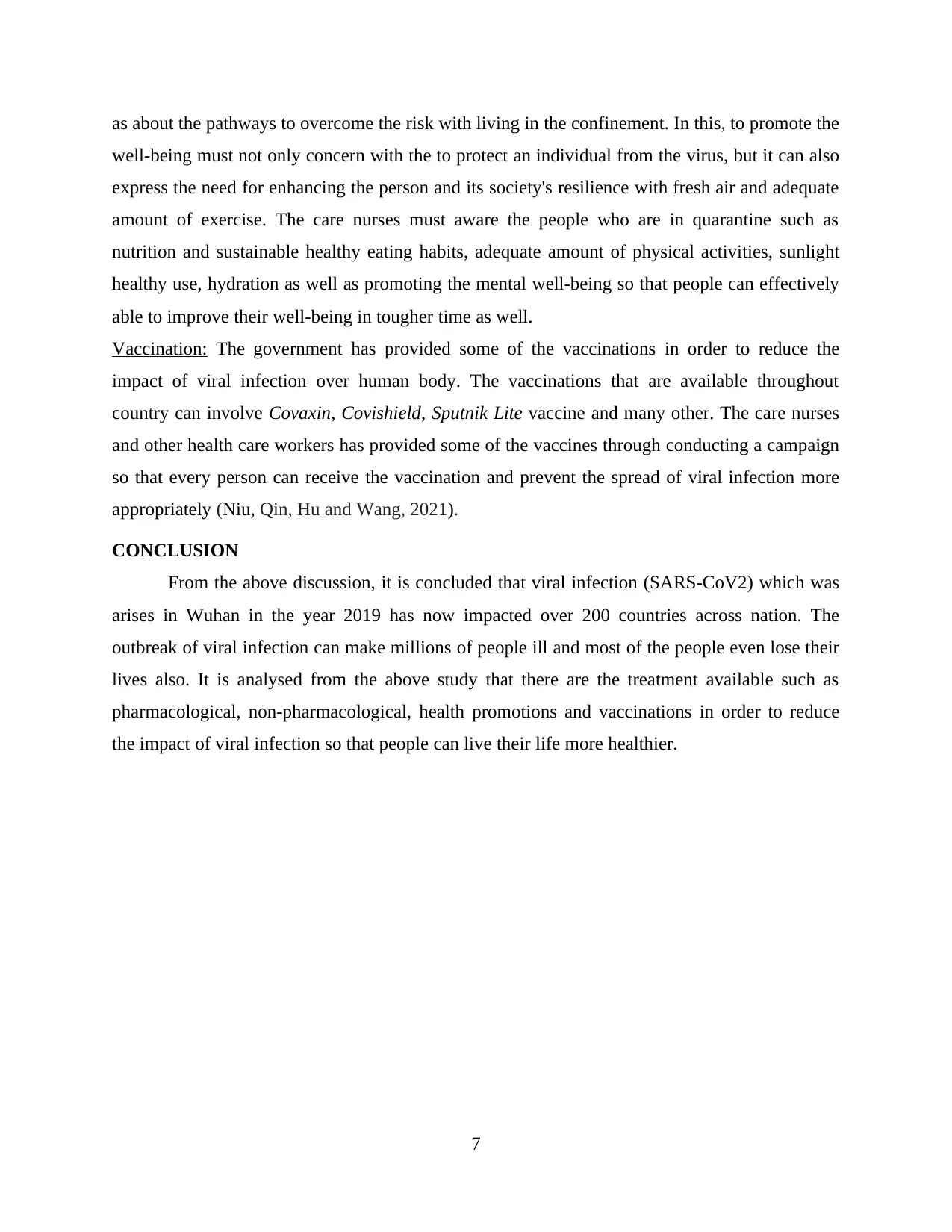
as about the pathways to overcome the risk with living in the confinement. In this, to promote the
well-being must not only concern with the to protect an individual from the virus, but it can also
express the need for enhancing the person and its society's resilience with fresh air and adequate
amount of exercise. The care nurses must aware the people who are in quarantine such as
nutrition and sustainable healthy eating habits, adequate amount of physical activities, sunlight
healthy use, hydration as well as promoting the mental well-being so that people can effectively
able to improve their well-being in tougher time as well.
Vaccination: The government has provided some of the vaccinations in order to reduce the
impact of viral infection over human body. The vaccinations that are available throughout
country can involve Covaxin, Covishield, Sputnik Lite vaccine and many other. The care nurses
and other health care workers has provided some of the vaccines through conducting a campaign
so that every person can receive the vaccination and prevent the spread of viral infection more
appropriately (Niu, Qin, Hu and Wang, 2021).
CONCLUSION
From the above discussion, it is concluded that viral infection (SARS-CoV2) which was
arises in Wuhan in the year 2019 has now impacted over 200 countries across nation. The
outbreak of viral infection can make millions of people ill and most of the people even lose their
lives also. It is analysed from the above study that there are the treatment available such as
pharmacological, non-pharmacological, health promotions and vaccinations in order to reduce
the impact of viral infection so that people can live their life more healthier.
7
well-being must not only concern with the to protect an individual from the virus, but it can also
express the need for enhancing the person and its society's resilience with fresh air and adequate
amount of exercise. The care nurses must aware the people who are in quarantine such as
nutrition and sustainable healthy eating habits, adequate amount of physical activities, sunlight
healthy use, hydration as well as promoting the mental well-being so that people can effectively
able to improve their well-being in tougher time as well.
Vaccination: The government has provided some of the vaccinations in order to reduce the
impact of viral infection over human body. The vaccinations that are available throughout
country can involve Covaxin, Covishield, Sputnik Lite vaccine and many other. The care nurses
and other health care workers has provided some of the vaccines through conducting a campaign
so that every person can receive the vaccination and prevent the spread of viral infection more
appropriately (Niu, Qin, Hu and Wang, 2021).
CONCLUSION
From the above discussion, it is concluded that viral infection (SARS-CoV2) which was
arises in Wuhan in the year 2019 has now impacted over 200 countries across nation. The
outbreak of viral infection can make millions of people ill and most of the people even lose their
lives also. It is analysed from the above study that there are the treatment available such as
pharmacological, non-pharmacological, health promotions and vaccinations in order to reduce
the impact of viral infection so that people can live their life more healthier.
7
⊘ This is a preview!⊘
Do you want full access?
Subscribe today to unlock all pages.

Trusted by 1+ million students worldwide
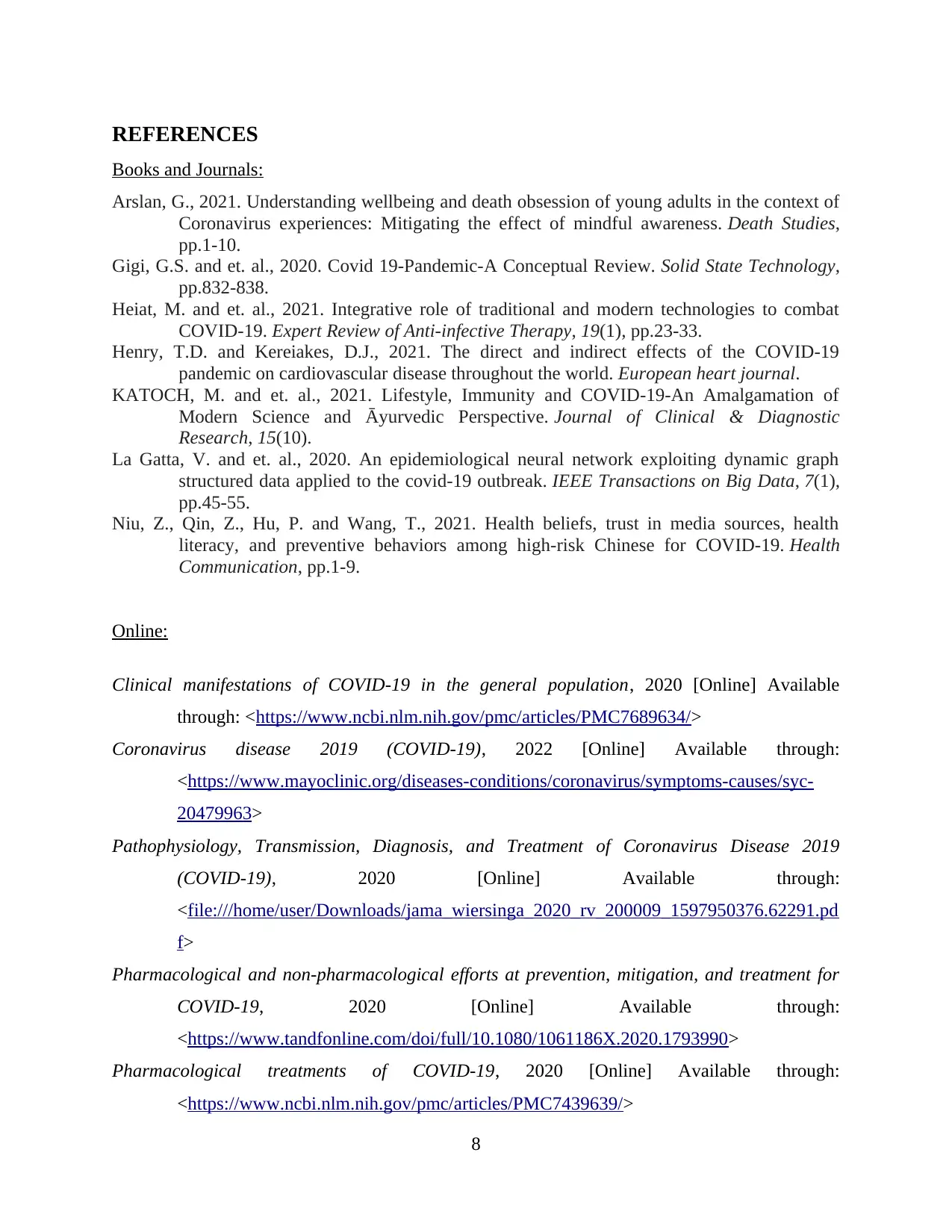
REFERENCES
Books and Journals:
Arslan, G., 2021. Understanding wellbeing and death obsession of young adults in the context of
Coronavirus experiences: Mitigating the effect of mindful awareness. Death Studies,
pp.1-10.
Gigi, G.S. and et. al., 2020. Covid 19-Pandemic-A Conceptual Review. Solid State Technology,
pp.832-838.
Heiat, M. and et. al., 2021. Integrative role of traditional and modern technologies to combat
COVID-19. Expert Review of Anti-infective Therapy, 19(1), pp.23-33.
Henry, T.D. and Kereiakes, D.J., 2021. The direct and indirect effects of the COVID-19
pandemic on cardiovascular disease throughout the world. European heart journal.
KATOCH, M. and et. al., 2021. Lifestyle, Immunity and COVID-19-An Amalgamation of
Modern Science and Āyurvedic Perspective. Journal of Clinical & Diagnostic
Research, 15(10).
La Gatta, V. and et. al., 2020. An epidemiological neural network exploiting dynamic graph
structured data applied to the covid-19 outbreak. IEEE Transactions on Big Data, 7(1),
pp.45-55.
Niu, Z., Qin, Z., Hu, P. and Wang, T., 2021. Health beliefs, trust in media sources, health
literacy, and preventive behaviors among high-risk Chinese for COVID-19. Health
Communication, pp.1-9.
Online:
Clinical manifestations of COVID-19 in the general population, 2020 [Online] Available
through: <https://www.ncbi.nlm.nih.gov/pmc/articles/PMC7689634/>
Coronavirus disease 2019 (COVID-19), 2022 [Online] Available through:
<https://www.mayoclinic.org/diseases-conditions/coronavirus/symptoms-causes/syc-
20479963>
Pathophysiology, Transmission, Diagnosis, and Treatment of Coronavirus Disease 2019
(COVID-19), 2020 [Online] Available through:
<file:///home/user/Downloads/jama_wiersinga_2020_rv_200009_1597950376.62291.pd
f>
Pharmacological and non-pharmacological efforts at prevention, mitigation, and treatment for
COVID-19, 2020 [Online] Available through:
<https://www.tandfonline.com/doi/full/10.1080/1061186X.2020.1793990>
Pharmacological treatments of COVID-19, 2020 [Online] Available through:
<https://www.ncbi.nlm.nih.gov/pmc/articles/PMC7439639/>
8
Books and Journals:
Arslan, G., 2021. Understanding wellbeing and death obsession of young adults in the context of
Coronavirus experiences: Mitigating the effect of mindful awareness. Death Studies,
pp.1-10.
Gigi, G.S. and et. al., 2020. Covid 19-Pandemic-A Conceptual Review. Solid State Technology,
pp.832-838.
Heiat, M. and et. al., 2021. Integrative role of traditional and modern technologies to combat
COVID-19. Expert Review of Anti-infective Therapy, 19(1), pp.23-33.
Henry, T.D. and Kereiakes, D.J., 2021. The direct and indirect effects of the COVID-19
pandemic on cardiovascular disease throughout the world. European heart journal.
KATOCH, M. and et. al., 2021. Lifestyle, Immunity and COVID-19-An Amalgamation of
Modern Science and Āyurvedic Perspective. Journal of Clinical & Diagnostic
Research, 15(10).
La Gatta, V. and et. al., 2020. An epidemiological neural network exploiting dynamic graph
structured data applied to the covid-19 outbreak. IEEE Transactions on Big Data, 7(1),
pp.45-55.
Niu, Z., Qin, Z., Hu, P. and Wang, T., 2021. Health beliefs, trust in media sources, health
literacy, and preventive behaviors among high-risk Chinese for COVID-19. Health
Communication, pp.1-9.
Online:
Clinical manifestations of COVID-19 in the general population, 2020 [Online] Available
through: <https://www.ncbi.nlm.nih.gov/pmc/articles/PMC7689634/>
Coronavirus disease 2019 (COVID-19), 2022 [Online] Available through:
<https://www.mayoclinic.org/diseases-conditions/coronavirus/symptoms-causes/syc-
20479963>
Pathophysiology, Transmission, Diagnosis, and Treatment of Coronavirus Disease 2019
(COVID-19), 2020 [Online] Available through:
<file:///home/user/Downloads/jama_wiersinga_2020_rv_200009_1597950376.62291.pd
f>
Pharmacological and non-pharmacological efforts at prevention, mitigation, and treatment for
COVID-19, 2020 [Online] Available through:
<https://www.tandfonline.com/doi/full/10.1080/1061186X.2020.1793990>
Pharmacological treatments of COVID-19, 2020 [Online] Available through:
<https://www.ncbi.nlm.nih.gov/pmc/articles/PMC7439639/>
8
Paraphrase This Document
Need a fresh take? Get an instant paraphrase of this document with our AI Paraphraser
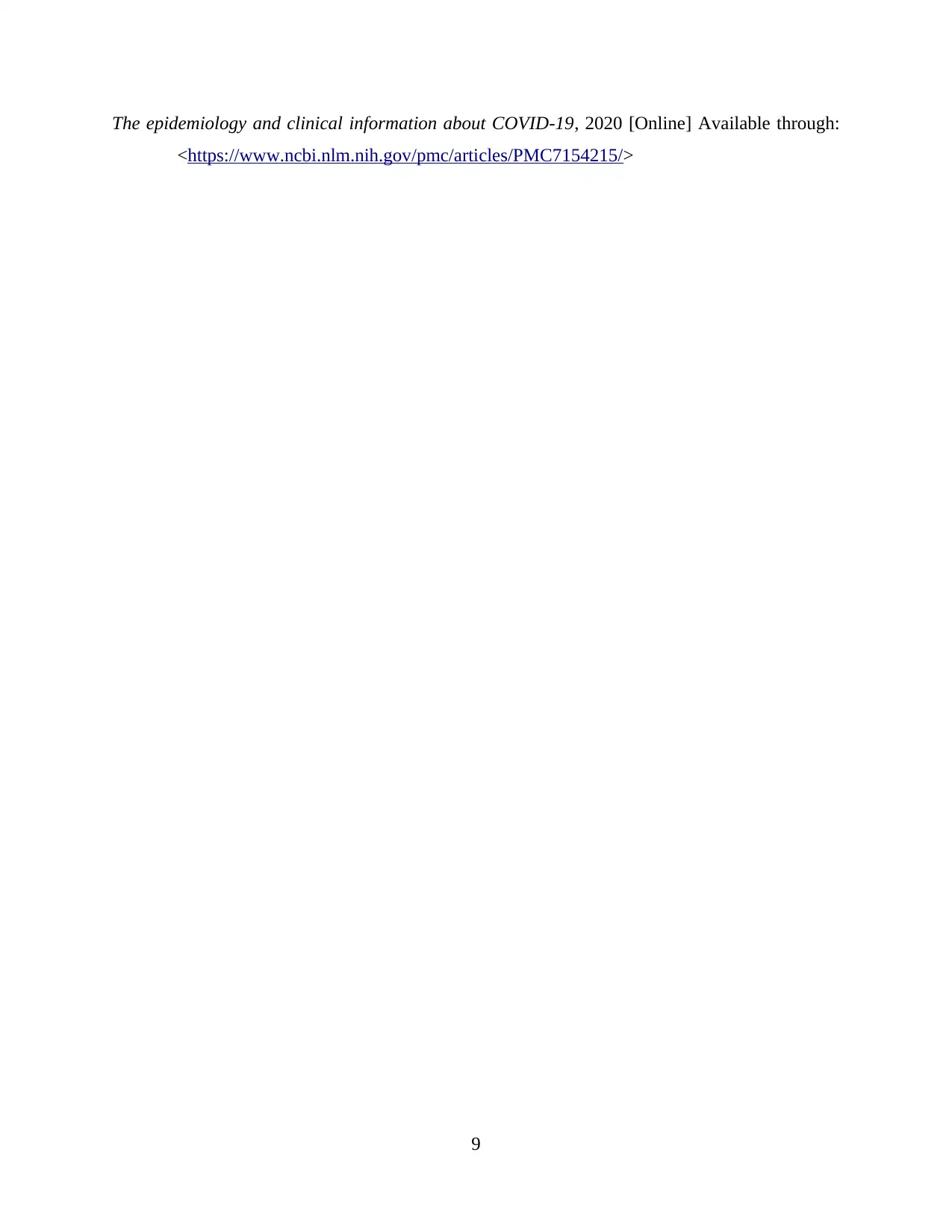
The epidemiology and clinical information about COVID-19, 2020 [Online] Available through:
<https://www.ncbi.nlm.nih.gov/pmc/articles/PMC7154215/>
9
<https://www.ncbi.nlm.nih.gov/pmc/articles/PMC7154215/>
9
1 out of 11
Related Documents
Your All-in-One AI-Powered Toolkit for Academic Success.
+13062052269
info@desklib.com
Available 24*7 on WhatsApp / Email
![[object Object]](/_next/static/media/star-bottom.7253800d.svg)
Unlock your academic potential
Copyright © 2020–2026 A2Z Services. All Rights Reserved. Developed and managed by ZUCOL.





